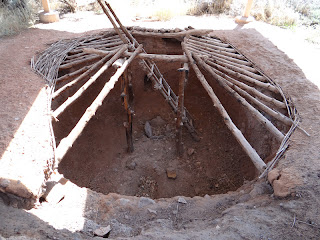Today we continued to do some heavy duty traveling.
The first stop on our journey was the Fremont River valley, the little town of Fruita, in particular. The geology of this region changes every 50 miles. After passing through a landscape marked by desert and barren badlands, we entered Capital Reef National Park, marked by canyons and huge bluffs. In the middle of the park is a broad and fertile flood plain filled with orchards: Fruita.
The Fremont Indians obviously liked this area too--good hunting and good soil for corn. In fact, their culture--spread from here as far north as Wyoming--was named after the Fremont River culture.
Here at Fruita is a curious set of petroglyphs in a amphitheater setting.
It is a curious matter because the figures resemble Fremont figures we saw earlier in Vernal, Utah, 250 to the northeast--at the McConkie Ranch and McKee Springs.
The Fremont petroglyphs between the two locales (like Nine-Mile Canyon) are totally different. Go figure.
No hikiing was needed this time. The highway runs right by it, as do the tourist buses.
This bus was filled with French speakers. I imagine they are on their way to the Grand Canyon from Moab; or is it Las Vegas?
We liked the way one of the rams was looking at another.
Another seemed to have something to say.
Very animated figures, unlike many stiff animals we often see. One spooky image was a paw or hand that seemed to emerge out of the rock.
As we got to the quiet town of Boulder, Utah, we stopped at the Anasazi State Park and Museum. What makes this location unique is that it was the last outpost of Ancestral Puebloan culture, in an area dominated by Fremont culture.
It is called the Coombs site and was excavated just a few decades ago. The ruins reflect Pueblo I and II cultures: a mix of pithouses
and small pueblo units
simultaneously gathered together in a village aggregation.
The retention of pithouses was probably due to the fact that they are warmer in winter and cooler in summer that adobe pueblo structures.












No comments:
Post a Comment